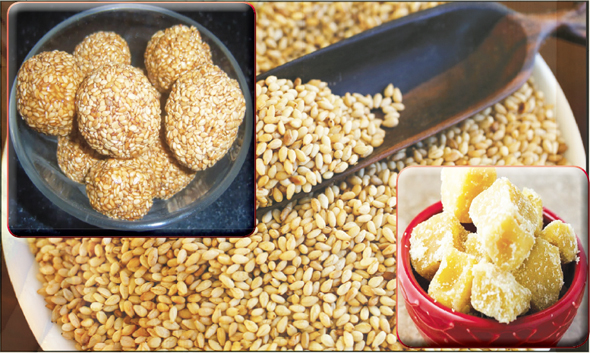Mama’s Punjabi Recipes: Til Bhuga Pinni (Jaggery Sesame Seed Balls)
It’s a fact that Indians like dried fruits, especially nuts of all kinds, and any time they have a chance, they will munch on them, especially cashews, almonds and pistachios. And far from being eaten alone, dried fruits can be found in cooking both sweet and salty dishes. Raisins and cashew nuts are often used in spicy biryanis (mixed rice) or equally well when making sweet kheer (rice pudding), mitthi seviyaan (sweet vermicelli), gajjar da halva (carrot pudding), burfi (congealed milk squares) or many other sweet dishes.
It’s not just the big nuts that are popular, but also the smaller seeds, like kharbuja giri (cantaloupe seeds), tarbuj giri (watermelon seed), til (sesame seeds) or a host of other seeds. These are used in ladoos (sweet balls) made of fried or regular besan (chickpea flour) and other delicately flavored dishes.
Til (sesame seeds) have a special place in the Punjab and the North as they are considered a “warm” seed – give you lots of energy and keep you warm – and are harvested during the winter months. Sesame seeds have one of the highest oil contents and are rich in calories, protein, dietary fiber and total fat. After oil extraction from sesame seeds, the flour that remains contains 35-50% protein and is used to feed poultry and livestock. Myanmar is the largest producer of sesame seeds; India the largest exporter and Japan the largest importer.
When coupled with gur (jaggery, a distilled concentrate of brown molasses of sugar cane juice or date palm), many types of sweets are made during the cold winter months. Growing up in rural India in Lyallpur, my family made the til bhuga and also other til items at home from fresh ingredients. These days, by late November and December, teams of young men come into the cities from their villages with the gur and sesame to make the long flatcakes of golden gajak (brittle of gur and til). Bazaars and hawkers quickly sell packets of gajak puffs and sesame coated over gur or chinni (sugar) gajak in almond-size and shaped pieces. Til bhuga is another variation of this in a pinni (ball) size with a different texture and taste.
Ingredients:
150gm til (sesame seeds)
150gm gur (brown Indian jaggery)
Directions:
1. Place the sesame seeds on a tava (flatplate) or frying pan and warm it up over medium heat for a minute, stirring continuously. Be careful not to burn them.
2. Take the til off and place them on a plate to cool off.
3. Break the gur into small pieces. Pour the til in a mortar and pestle or in a small mixee and crush them into a coarse powder. The til will shed some oil.
4. Now add the gur and continue to crush the two together. The gur will start to clump together with the til.
5. Take a small amount of the mixture and knead into a 1 inch ball. Coat your hands with some vegetable oil so that the ball will not stick.
6. Make all the pinnis and place on a tray and serve. Because no water is used in the preparation, you can store the pinnis for long durations by storing in a tightly sealed jar.
MAMA’S TIP OF THE WEEK
FOR SOFT GULAB JAMUN, ALWAYS START WITH WARM INGREDIENTS
Many people enjoy gulab jamun (rose colored syrup balls) and it is a sweet dish very often served in restaurants and at private parties. They are best served a little warm, in slightly warm syrup, though they can also be served in small cups at room temperature.
What makes them delicious is their soft texture, but there is a simple trick to that. Take all the ingredients – cream, water, milk etc. – out of the fridge and let them stay at room temperature for at least an hour before using them to knead the dough. If you use these straight out of the fridge, the gulab jamun will turn out hard once you fry them and will not fluff up in the syrup.
Shakuntla Malhotra is a skilled cook of Punjabi dishes made in the old-fashioned style that she learnt as a young woman in her ancestral home in Lyallpur, India before it became part of Pakistan after the Partition in 1947. People have often admired her cooking for its simplicity and taste that comes with each mouthful. Even in her mid-eighties, she continues to cook daily and agreed to share some of her delectable Punjabi recipes.


